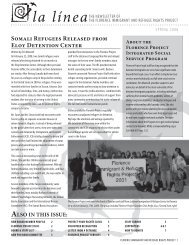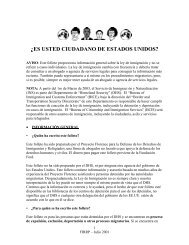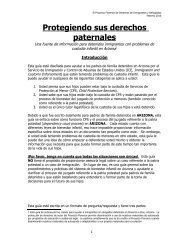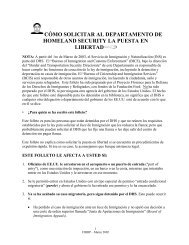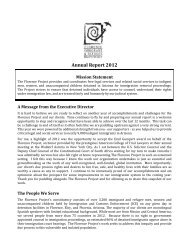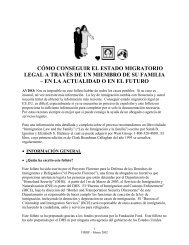HOW TO APPLY FOR ASYLUM - The Florence Project
HOW TO APPLY FOR ASYLUM - The Florence Project
HOW TO APPLY FOR ASYLUM - The Florence Project
You also want an ePaper? Increase the reach of your titles
YUMPU automatically turns print PDFs into web optimized ePapers that Google loves.
for any questions that DHS might ask you based on the report.<br />
You can get a copy of this report by calling or writing to the lawyer who represented you in criminal court. If<br />
you do not remember who that was, you can ask a DHS officer to look in your file. <strong>The</strong> paper from criminal<br />
court should show the name of your lawyer. If the lawyer was a public defender (not someone you paid), you<br />
can call or write the public defender’s office in the county or city where your case was.<br />
• DHS’s File<br />
You can get a copy of what is in your immigration file by making a “Freedom of Information /Privacy Act<br />
Request (Form G-639).” You do this by filling out a Form G-639. Ask a DHS officer for one. If you are<br />
detained, your address on the form should be your address at the detention center. If a question does not apply<br />
to you, write “not applicable.” You need to sign the form in several places. First, under question number two,<br />
where it says “Signature of Requester,” then under number seven, where it says “Signature of Subject of<br />
Record,” and last under number eight which begins, “If executed within the United States…”. By signing, you<br />
agree to pay copying costs, but in most cases, there will not be any charge.<br />
After you fill out the form, mail the original to DHS and write “FOIA Request” on the envelope. <strong>The</strong> person<br />
who deals with these papers may be at a different address than where you mail your other papers, so ask an<br />
officer for the address of the “FOIA officer” for the DHS district where you are. Keep a copy for yourself. Do<br />
not send a copy of this form to the Court.<br />
It can take a long time to get a response to your request, and you may have your hearing before then. But, it<br />
does not hurt to file the form and it may help you by letting you know what DHS may try to prove against<br />
you in Court. Seeing your file gives you the chance to get ready to talk about your criminal and immigration<br />
history in Court or to object to certain papers DHS's attorney may want the judge to consider.<br />
• FBI Records<br />
If you have criminal convictions, one of the documents DHS has in your file is a “rap sheet” from the Federal<br />
Bureau of Investigations (FBI), which lists your criminal history, including any arrests, even if you were not<br />
convicted. You can usually get this faster than you can get a copy of your DHS file. Send 1) a completed<br />
fingerprint card (Form FD-258), 2) a money order for $18 made out to the “FBI,” and 3) a letter asking for<br />
your rap sheet. You must sign the letter and indicate the address to which the rap sheet should be mailed. You<br />
should also indicate the date by which you need the record as it can take up to eight weeks. Send to:<br />
Do not send a copy to the Court or DHS.<br />
Federal Bureau of Investigations – CJIS Division<br />
1000 Custer Hollow Road<br />
Clarksburg, West Virginia 26306<br />
• WHAT WILL HAPPEN AT MY INDIVIDUAL HEARING<br />
At your final hearing, you get to tell your story and the judge decides your case. At the hearing, the Immigration<br />
Judge, an interpreter (if you are not fluent in English), the lawyer representing DHS (called the "trial attorney"),<br />
and you will all be present. If you have witnesses, they have to be there, too. DHS may have witnesses against<br />
Page 35 of 49<br />
FIRRP- last update June 2007




